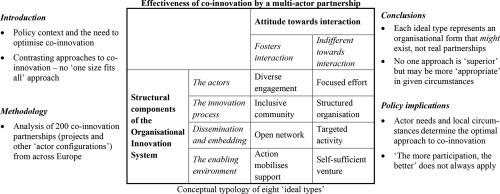Agricultural Systems ( IF 6.6 ) Pub Date : 2022-08-19 , DOI: 10.1016/j.agsy.2022.103472 Andrew F. Fieldsend , Eszter Varga , Szabolcs Biró , Susanne Von Münchhausen , Anna Maria Häring

|
CONTEXT
Innovation is an important driver of increased productivity, sustainability and resilience in agriculture, forestry and related sectors. An analysis of how different types of multi-actor co-innovation partnerships function can help to identify the reasons why some are more successful than others in ‘speeding up’ innovation.
OBJECTIVE
To provide a framework for the analysis of the co-innovation process, we developed a multidimensional conceptual typology of co-innovation activities based on a review of 200 such partnerships involving farmers and foresters from across Europe. This framework is based on innovation systems theory and the prevailing policy context of the ‘multi-actor approach’.
METHODS
The overarching concept or dependent variable measured by the typology is ‘effectiveness of co-innovation by a multi-actor partnership’ and the two dimensions of the overarching concept are the ‘structural components of the Organisational Innovation System’, with four categories, and ‘attitude towards interaction’, with two categories. The result is a matrix of eight ‘ideal types’ of co-innovation activity. These eight types are characterised according to first-order constructs derived from our research data.
RESULTS AND CONCLUSIONS
The results show that the co-innovation process can successfully take contrasting forms according to the ‘contextual contingencies’ encountered by the partnership. In other words, no one ideal type is intrinsically ‘superior’ to another but may be more ‘appropriate’ in given circumstances. Factors influencing approaches to implementation include actor capacities, aspirations and networks, the co-innovation topic and its influence on the partnership size and the workplan structure, the type of co-innovation activity outputs and the need to engage with the ‘larger periphery’ of stakeholders, and the nature of the enabling environment.
SIGNIFICANCE
The typology is not a classification since the ideal types represent organisational forms that might exist rather than real partnerships. However, the analytical framework it provides will help policy makers and programme managers to develop targeted interventions, according to actor needs and local circumstances, for ‘speeding up’ innovation.
中文翻译:

欧洲农业、林业和相关部门的多方合作创新伙伴关系:不同的实施方法
语境
创新是提高农业、林业和相关部门生产力、可持续性和复原力的重要驱动力。分析不同类型的多方共同创新合作伙伴关系如何发挥作用,有助于确定一些在“加速”创新方面比其他合作伙伴更成功的原因。
客观的
为了提供一个分析共同创新过程的框架,我们基于对 200 个涉及欧洲农民和林农的此类合作伙伴关系的审查,开发了一个共同创新活动的多维概念类型。该框架基于创新系统理论和“多方方法”的普遍政策背景。
方法
由类型学衡量的总体概念或因变量是“多方合作伙伴共同创新的有效性”,总体概念的两个维度是“组织创新系统的结构组成部分”,有四个类别,以及“对互动的态度”,分为两类。结果是一个由八种“理想类型”共同创新活动组成的矩阵。这八种类型的特征是根据我们的研究数据得出的一阶结构。
结果和结论
结果表明,根据合作伙伴遇到的“情境偶然性”,共同创新过程可以成功地采取对比形式。换句话说,没有一种理想类型在本质上“优于”另一种,但在特定情况下可能更“合适”。影利益相关者,以及有利环境的性质。
意义
类型学不是一种分类,因为理想类型代表可能存在的组织形式,而不是真正的伙伴关系。然而,它提供的分析框架将帮助政策制定者和项目管理者根据参与者的需求和当地情况制定有针对性的干预措施,以“加速”创新。



























 京公网安备 11010802027423号
京公网安备 11010802027423号